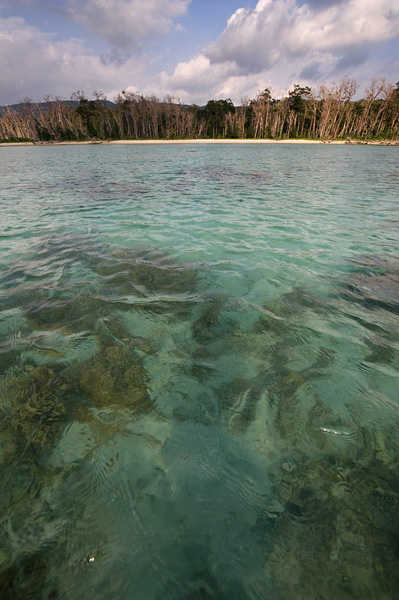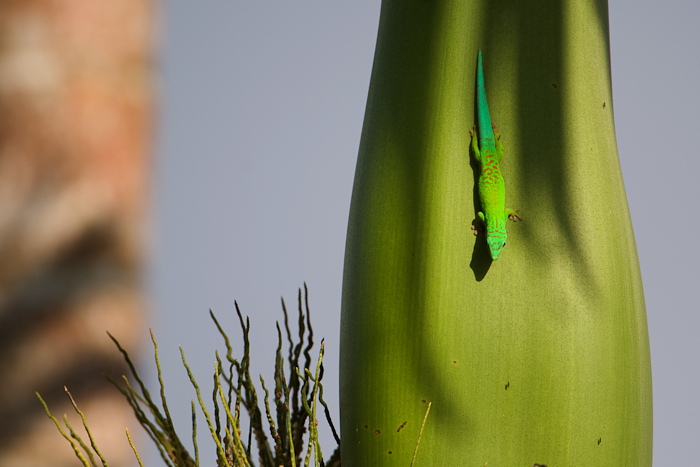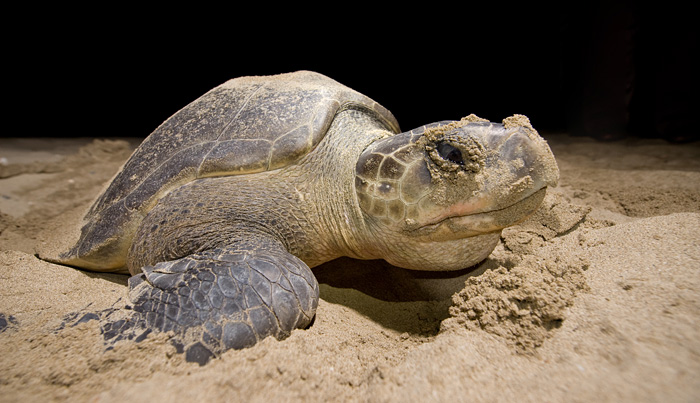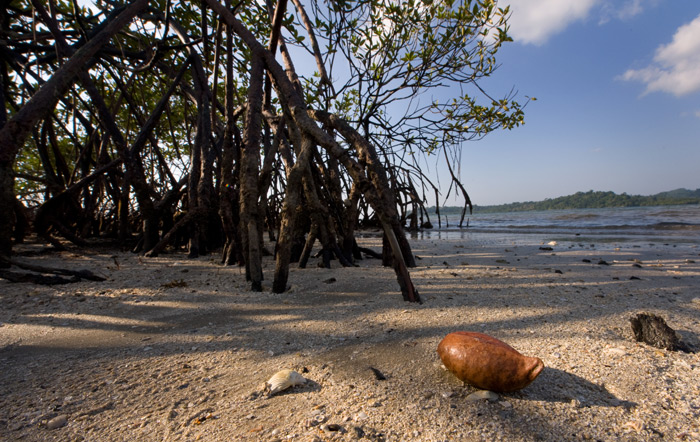The Andaman Islands
This is the image that everyone has of the Andaman and Nicobar Islands. Clear blue waters, white sandy beaches which transform into lush rainforests as you move onto the land.

The truth however is quite contrary.
There is very little of original, undisturbed, pristine rainforests left. The Andamans were the timber source for mainland India for many decades. In fact till recently, the largest saw-mill in Asia was operated out of there. People in mainland India were given incentives like 10 tons of wood every year to settle down in the Andamans and ‘colonize’ the islands. Burmese people even today come into the islands, cut down the tallest trees, tie them all together and toe them back to Myanmar.
The People

Great Andamanese hunters, in an 1875 photograph (source commons)
The real tragedy has been with the local tribes. There were 6 different tribes in the Andaman and Nicobar Islands. While a few of them (Jarawa, Sentinelese, Onge, Great Andamanese) are of Negroid origin, the others are Mongoloid (Shompen, Nicobarese) and have been living there for thousands of years and possibly represent a very critical link in human migration. The Andamans are theorized to be a key stepping stone in a great coastal migration of humans from Africa via the Arabian peninsula, along the coastal regions of the Indian mainland and towards Southeast Asia, Japan and Oceania. First, the European and Central Asian sailors tried to make slaves out of them. This made them wary of the outside world and have always treated outsiders with hostility. Then the British moved into these islands and tried to make contact with them. This contact led to spread of diseases and also alcoholism and other bane of the modern society. History repeated itself, and like the Amazon and Mayan tribes, the populations of these tribes also plummeted.
Great Andamanese who’s population used to be 5000+, plummeted to 600 by 1901. Today less than 30 of them survive. Jarawas which were also in few thousands have dropped to 300 and restricted to a small part of their former territory – the Jarawa Reserve in the west coast of the South and Middle Andamans. There is a main highway going through their reserve which has become the source of contact and interactions between these tribes and the settlers. The settlers being mostly people from West Bengal, Tamil Nadu and Ranchi. Even though there is a Supreme Court order to shut down the road, it is still operational.
Onge which live in Little Andaman have less than a 100 people left. The only tribe which still maintains no contact with the outside world are are the Sentinelese. There are an estimated 300 left on the North Sentinel Island.
Just last month, one of the sub-tribes of Andamanese became extinct when the last of its member passed away.
Tsunami
Tsunami has transformed the islands and left its scar forever. There is life before the Tsunami and then there is the life after.
There was a lot of lives lost and a lot of damage to the property. The real damage came not from the wave of water but from the earthquakes that shook the islands during that time. The islands got tilted and land got submerged into waters or got lifted up. A lot of coral reefs died because they were lifted by a few feet. The little change in depth can change the temperature and that led to the mass dying of the corals. Some even got lifted above the sea level. A lot of fertile land got submerged and now they are just marshes with submerged and abandoned houses in between and a lot of palm trees without their crowns.

Dead corals that were pushed above the water by the earthquake
The Tsunami also changed the social landscape of the islands. The government lifted the ban on logging and opened up the rainforests to support the people. A lot of money that was pumped into the relief efforts has changed the economic balance of the island people. Everyone owns a badly built fishing boat that were presented to them post-tsunami. Now most of them are broken down because of the bad quality and whats left are used for tourism purposes. There has been a boom in tourism too. These obscure islands became popular. All the money that came in as relief were quickly converted to resorts.
Wildlife
This was the first time I’ve experienced ‘island ecosystem’. Basically, these islands have been remote for so long that, no mammals have reached here. Every time I heard something, I would look in the understory to look out for some deer etc.. but then realise that there are no mammals in these islands and the sound was either another person or a stray dog. The real diversity of these islands is in the plants, reptiles and birds. Most birds here are endemic and are relatives of the mainland birds like the Andaman Serpent Eagle, Andaman Coucal, Andaman Teal, Andaman something or the other! The same story goes with the snakes and lizards too. One of the extraordinary reptile here is the Andaman Day Gecko Phelsuma

Andaman Day Gecko
Unlike regular geckos, this one is diurnal, very colourful and you are almost sure to find one on every areca (betel nut) tree if you look carefully. They are most active during mid day when they come out to catch flies that land on the inflorescence of these plants.

Andaman Crake – One of the many endemic birds

Olive Ridley Turtle nesting on the Ramnagar beach

Heritiera littoralis seed
My favorite is this mangrove plant whose boat-shaped seed has a small ‘keel’ or sail on top to help it disperse across the open oceans riding the waves. Were these the inspiration when humans first made the sail boats ?
The other highlight was the Edible-nest swiftlets for which I’ll write a separate post.
Loved the Day Gecko and Crake pictures – must have been an awesome trip! Come over and we will go to photograph the forest Owlet!
Yeah.. been wanting to photograph the forest owlet for a while now. Is it found throughout the year or any specific time ?
Great post Kalyan. The tribal story is a tragedy. Loved the Day Gecko photo. Have any close-ups?
Must have been a great trip.. Yes, it is sad reading the status of the island.Your narration will definitely help me when I plan my trip to the islands.
Geetanjali
Hi kalyan,
TFS, Very nice article.. very informative ,an real eye opener for me ..
and brilliant photographs asusual……
very different from the usual Andaman stories I have read..and great pics as always..
Really you shook my beliefs about Andamans. this issue should be highlighted, or we will lose a great treasure.
March would be a good month – the tree would have shed leaves and visibility will be better.
This is an eye-opener Kalyan. I had no idea that an island-ecosystem could exist. Great write-up and lovely pictures as always. Looking forward to some hornbill pictures.
nice article. I got to know lot new insights.
Keep writing
‘The Land of Naked People: Encounters with Stone Age Islanders’ (http://www.amazon.com/dp/0618197362) is a pretty good book to read about contemporary concerns about the Andamans
You are just brilliant Kalyan! Congratulations on more awesome photos and an inspiring blog.
always thought mangrove seeds went straight in to the ground like shafts… this boat shaped one is amazing and i love that photo. cool stuff! thanks 🙂
Arati…most of the mangrove seeds are buoyant – in a specific way so as to float and reach suitable places during the tides as well have the “right side up”.
Wonderfully illuminating write-up, Kalyan! Thanks for all the information. I hadn’t known this side of the islands. They are such a treasure trove and it is sad that the mainland people are hardly aware of these things.Lovely photographs too.
Thanks for the interesting write-up and pictures, Kalyan ! The observation of no mammals there is very interesting. The real tragedy indeed, is the people.
I m a local of Andaman & Nicobar Islands. I happened to read the Write-up of Shri Kalyan Varma just now, although it was written in 2010. The observation that tnere are no mammals here in our islands is a wrong & misleading one! We have cows, buffaloes, goats, pigs, langurs & even elephants among domestic animals, while deer, wild-goat, boar etc constitute the wildlife here. I wonder how such a blunder could be published that there are no mammals here in our islands! Yes we dont have lion, tiger, leopard etc.
The combination of photography and writing reaches out to larger audience in telling them the story of environmental degradation .
This story of Andamans is new to many of us ! Thanks for posting this !
Thought provoking article Kalyan. To think that i traveled to the islands and came back with no such thoughts i feel like a dumb ass.I feel i didnt see the Andamans at all. I take this as a lesson.
nice writeup kalyan … and luved that day gecko shot!
Hi Kalyan,
sorry to differ a little. 55 terrestrial and 7 marine mammal species reported from the Islands. though most are ferral or introduced 5 are endemic to the Islands (3 species of shrews, andaman horseshoe bat and one species of rat ) andaman wild pig, dugongs ,crab eating macaques(nicobars) are some other near endemic species.Deer can be seen on the Ross island and along the Andaman Trunk Road (Jarawa Area, out of bounds).Also Baratang creek is the only place in the world to see the sea going elephants.
Simply Great photos though.
I’m sorry for not including marine mammals. I was referring to terrestrial mammals. The ones you mentioned are found in Nicobar, but not in Andaman islands. The deers, macaques, civets and elephants have been introduced by people in the last 100 years and are almost have a negative effect on the other island species. They are there, but are not native at all. Infact right now the forest dept is looking at ways to taking out all the spotted deers from the Islands.
Lovely pics and nice write-up. It is indeed sad to hear about the exploitations going on. But with more awareness brought about by people such as you and others will hopefully help change the situation for the better.
Interesting theory about the boat-shaped seed. Do you know anyone who’s doing research on this?
Do you have any underwater photographs ? I would love to see some if you do !
Like you have mentioned the picturesque view of the Island is what many people know of. Its very important that people are made of of the real picture. I love the Dead corals pic, the tries in B&W… actually all of them. But not to mention the Turtle thats very close to my heart..
Hey did you manage to get some info on the Tag?
The clear blue water with a backdrop of rainforests in truly mesmerizing.
This post brings back memories, i have spent close to a year (1997 -1998)on the islands, I have personally lost 12 of friends during the Tusnami on the car nicobar tragedy. It is shocking to know that many places including Radha Nagar beach has been devastated. Amazing Photos do you have Photographs of the dolphins, which used swim along with the ship as you reach Port Blair. Great post.
I went by flight. So missed the joy of approaching Andamans by the sea 🙂
Hey, Radhanagar beach still looks pretty decent. Wonder how it must have looked before the Tsunami.
Dear sir,
I’m a research scholar(Dept. of Disaster management-Port Blair), sir, if you have any information about Andaman’s people migration after the 2004 tsunami, please provide me.
Thank you for the article, The History of Deforestation in the Andaman and Nicobar Islands is indeed of considerable interest. Why don’t we find and install useful apps to participate in environmental protection activities and raise awareness about sustainability on apps at apktome to put them into practice. Apktome offers a wide range of apps that guide and provide information on how to reduce human impact on the environment. These apps can provide knowledge about saving energy, sorting waste, using water efficiently, and advocating for recycling and reuse. While the image of the Andaman and Nicobar Islands as a tropical paradise is still appealing, it is important to raise awareness of the need for sustainable practices and conservation efforts to ensure their survival. the long-term survival of these fragile ecosystems.
Thank you for sharing your experience and continuing your expedition to Narcondam Island. I also love to travel, but due to economic conditions and time, I have not been able to take a trip here, I only have time in the evenings to entertain on gaming applications and watch movies on Mod APK modtodays. I can enjoy playing my favorite games for free. I also look forward to coming to this beautiful Narcondam Islands in the near future.
[…] 8537892699315186466398059064505498072662433838385702393294053036891495829168436 Post navigation ← Previous PostNext Post → […]